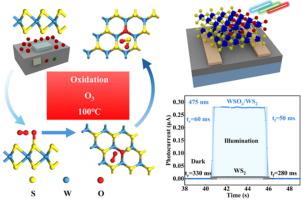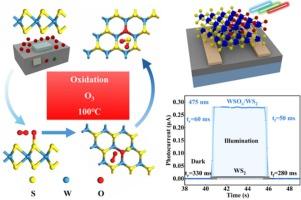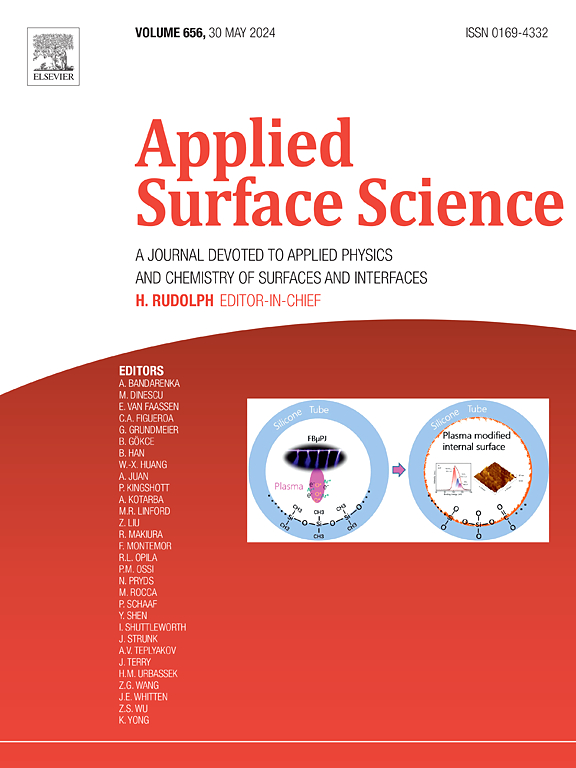High-performance type II WSOx/WS2-based heterojunction photodetectors
IF 6.9
2区 材料科学
Q2 CHEMISTRY, PHYSICAL
引用次数: 0
Abstract
Van der Waals heterojunctions (vdWHs) have garnered significant attention for their promising applications in optoelectronics, attributed to their exceptional physical attributes. In this study, we present a straightforward approach to fabricating high-performance vdWHs photodetectors. Specifically, we prepared WSOx/WS2 vdWH photodetectors through the ozone oxidation of a WS2 thin films at 100 °C. To characterize the morphology and optical properties of both the WS2 and WSOx/WS2 thin films, we utilized atomic force microscopy (AFM) and Raman spectroscopy. Additionally, X-ray photoelectron spectroscopy (XPS) was employed to delve into the structural evolution by scrutinizing the bonding states of W, O, and S in the WS2 before and after the ozone oxidation process. The resultant WSOx/WS2 vdWH photodetectors exhibited impressive photoelectric performance at wavelengths of 475 nm and 532 nm. It demonstrated a high responsivity of 230.7 A/W, a remarkable specific detectivity of 1.794 × 1011 Jones, and a swift response speed of 60 ms at 475 nm. Furthermore, first-principles calculations based on density functional theory (DFT) were conducted to validate the oxidation kinetics of monolayer WS2, the type II energy band alignment, and the interlayer charge transfer within the WSOx/WS2 vdWH. This research contributes novel insights into the synthesis of two-dimensional transition metal oxides (TMOs)-transition metal dichalcogenides (TMDCs) heterostructures for photodetector applications.


基于 WSOx/WS2 的高性能 II 型异质结光电探测器
范德瓦尔斯异质结(vdWHs)因其卓越的物理特性,在光电子学中的应用前景广阔,因而备受关注。在本研究中,我们提出了一种制造高性能 vdWHs 光电探测器的直接方法。具体来说,我们在 100 °C 下通过臭氧氧化 WS2 薄膜制备了 WSOx/WS2 vdWH 光电探测器。为了表征 WS2 和 WSOx/WS2 薄膜的形态和光学特性,我们使用了原子力显微镜 (AFM) 和拉曼光谱。此外,我们还采用了 X 射线光电子能谱 (XPS),通过仔细观察臭氧氧化过程前后 WS2 中 W、O 和 S 的成键状态来深入研究其结构演变。由此产生的 WSOx/WS2 vdWH 光电探测器在波长为 475 纳米和 532 纳米时表现出令人印象深刻的光电性能。它的响应率高达 230.7 A/W,比检出率高达 1.794 × 1011 Jones,在 475 nm 波长下的响应速度为 60 ms。此外,基于密度泛函理论(DFT)的第一原理计算验证了单层 WS2 的氧化动力学、II 型能带排列以及 WSOx/WS2 vdWH 中的层间电荷转移。这项研究为合成二维过渡金属氧化物(TMOs)-过渡金属二卤化物(TMDCs)异质结构用于光电探测器应用提供了新的见解。
本文章由计算机程序翻译,如有差异,请以英文原文为准。
求助全文
约1分钟内获得全文
求助全文
来源期刊

Applied Surface Science
工程技术-材料科学:膜
CiteScore
12.50
自引率
7.50%
发文量
3393
审稿时长
67 days
期刊介绍:
Applied Surface Science covers topics contributing to a better understanding of surfaces, interfaces, nanostructures and their applications. The journal is concerned with scientific research on the atomic and molecular level of material properties determined with specific surface analytical techniques and/or computational methods, as well as the processing of such structures.
 求助内容:
求助内容: 应助结果提醒方式:
应助结果提醒方式:


